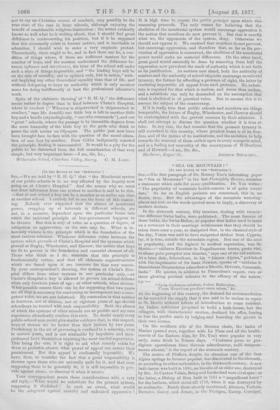"SEA OR MOUNTAIN ? "
[To THE EDITOR or TIM "SPECTATOR:I Sint—The first paragraph of Dr. Burney Yco's interesting paper on " Sea or Mountain F" in the last Fortnightly Review, contains a statement which calls for some qualification. Dr. Yeo writes " The popularity of mountain health-resorts is of quite recent date." So far as English patients are concerned, this is, no doubt, true. But the advantages of the mountain watering- places are not, as the words quoted seem to imply, a discovery of modern doctors, In the sixteenth century, fifty treatises, dealing with twenty- one different Swiss baths, were published. The most famous of these baths, the Swiss Baden, so popular that ladies used to insist on a covenant in their marriage settlements that they should be taken there once a year, so dissipated that, in the classical style of the day, Venus was said to have emigrated thither from Cyprus, lay, it is true, outside the mountain region. But one of the next in popularity, and the highest in medical reputation, was St. Moritz—" utiliores Rhosticas iu Engadinorum tractu, gustu vini, ut alieno potu peregrini non utautur," says one of the old authors. At a later date, &bench zer, in his " itinera Alpina," published with the imprimatur of Sir Isaac Newton, speaks of " acidelas S. Mauritianas frequentatas admodum a Rhcetis, Helvetis, Germanis, Rails." He quotes, in addition to Paracelsus's report, two or three glowing poetical tributes to the efficacy of the waters, e.g.
"Syria Jordanum oolobrat, Judaea Bothesdam, num Mauritium proodicat omue soluno," At the beginning of this century, the demand for accommodation so far exceeded the supply that it was said to be useless to repair to St. Moritz without letters of introduction to some resident. An Italian nobleman proposed to build a bath-house, but the villagers, with characteristic caution, declined his offer, fearing to lose the profits made by lodging and boarding the guests in their own houses.
On the southern side of the Bernina chain, the baths of Masiuo (passed over, together with Le Piese and all the health- resorts of the Eastern Alps, by Dr. Yeo) were popular in very early, some think in Roman days. " Ccelestes ptene tic pros digiosas operatioucs hisce thermis adscribuntur, nulli tempera- mento obsunt," is the report of the sixteenth century.
The source of Preffers, despite its situation one of the first Alpine springs to become popular, was discovered in the eleventh, or according to other authorities, in the thirteenth century. A new bath-house was built in 1530, on the site of an older one, destroyed by fire, In Canton Valais, Brieg and Leukerbad were rival spas ; at the latter, a 13iehop of Sion built in 1501 a " magnificent hotel" for the bathers, which stood till 1719, when it was destroyed by an avalanche. Beside those already mentioned, Alvenen, Vcderis, Bormieo, Galley, and Jenatz, in the Priitigau, Tarasp, Gurnigel, and Stachelberg, were known in early times. What the accommo- dation was like may be judged from the illustrations in the old books, or by a visit to such a remote spot as Tenniger Bad, iu side-glen of the Vorderrheinthal, where the original row of wooden troughs, fitted closely together, still remains.
Moreover, if our predecessors made water their first object, Alpine air was not undervalued. The following sentence is more than a hundred years old :—" C'est it la position de in Suisse, et aux moats de glace qui en sont l'effet nature], qu'est du Pair pur et sain qu'on y respire." One eighteenth-century writer suggests that the immunity from epidemics enjoyed of late by Alpine valleys which had suffered severely from the plague in the middle- ages may be attributed to an increase in the glaciers.
The study of the effects on the human frame of diminished atmospheric pressure and mountain climates is most important and interesting, and is in the right hands when taken up by practical
physicians. There is one fact not referred to by Dr. Yeo, which is, 1 think, as indisputable as the refreshing quality of glacier-air
he points out, The air on snow at heights of between 9,000 ft, and 11,000 ft.—that is, just before it becomes sufficiently rarified to impede in the slightest degree muscular exertion—produces a stimulating effect on the frame which destroys all sense of fatigue, and is far in excess of that experienced on the lower glaciers. It is practically impossible in Europe to live at such altitudes, and it is probable, from South-American observations, that such a stimulant is too strong for a permanency. But its value, taken in occasional doses, might be worth considering. The inn near the top of the Stelvio is excellently situated for trying the experi- ment. Invalids, however, who venture on these regions must submit to join the beroped and bespectacled caravan. But the
same objection applies, pace 1)r. Yeo, to his favourite promenade,
the Morteratsch Glacier. It is, perhaps, a little bold of him to speak of it " as a vast field of glacier, easily traversed in all direc- tions." If many of his patients follow, after the usuaLmanner of tourists, this advice, it may not, I fear, be long before one of. them finds a sudden cure in a crevasse.—I am, Sir, Sec.,
DoisoLas W. FliEsEFIELD.































 Previous page
Previous page